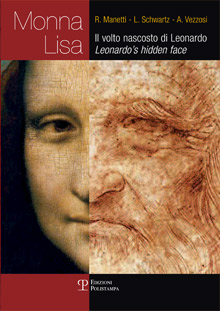
La studiosa americana Lillian Schwartz, mediante un’analisi computerizzata della Gioconda e dell’autoritratto di Leonardo, rileva impressionanti concordanze fra i lineamenti dei due volti, tanto da sostenere che Monna Lisa sia in realtà un vero e proprio autoritratto idealizzato del pittore.
Le ragioni di un così originale autoritratto sono individuate da Renzo Manetti in quella stessa filosofia che aveva dato vita anche alla musa ispiratrice di Dante. Come Beatrice, anche Monnalisa sarebbe l’immagine dell’alter ego celeste, che funge da guida verso la Sapienza, e per questo avrebbe gli stessi lineamenti del pittore. Tra queste tesi e quella di Vezzosi c’è la comune consapevolezza che il ritratto non raffiguri monna Lisa Gherardini, la moglie di Francesco del Giocondo. Secondo lo studioso esiste un solo documento attendibile coevo a Leonardo, quello che riporta quanto egli disse al cardinale d’Aragona da lui in visita nel 1517 in Francia: Monna Lisa era stata dipinta su richiesta di Giuliano dei Medici e pertanto era una sua favorita. Dunque non poteva essere la monna Lisa mulier ingenua di Francesco del Giocondo, modello virtuoso di moglie e di madre.
Il volume raccoglie opinioni fra loro non combacianti, ma in grado di offrire letture ancora nuove del dipinto forse più studiato e celebre della storia.
Formato PDF
In this book there are collected the three theories about the most studied and famous painting in history, Leonardo’s Gioconda, expressed during a round table within the event “Genio Fiorentino 2006” [Florentine Genius 2006], promoted by the Province of Florence and entitled “Mona Lisa: The Hidden Face of Leonardo”.
The three authors offer new interpretations of this masterpiece: Schwartz and Manetti theories’ are based on the firm belief that Mona Lisa is the idealized self portrait of Leonardo; Vezzosi claims that Mona Lisa does not represent Francesco Del Giocondo’s wife, which is contrary to what most of Leonardo’s experts believe. Lillian Schwartz supplies convincing facts to support her theories: the image under the painting revealed by the X-rays shows a different face from the one that appears on the surface. On the original face, perhaps the portrait of a real woman, Leonardo would have imprinted the actual features until he obtained the painting we know today. What Lillian does not explain is why Leonardo would have done this. Manetti’s hypothesis supplies an answer to this question, thus strengthening Schwartz’s research. Manetti believes in fact that Mona Lisa, initially conceived as a real portrait, ended up in an ideal image, the iconic talisman of Leonardo’s hidden face, the guiding spirit which the stilnovista tradition allegorically represented with the female angel and, therefore, with the feminine nature. Alessandro Vezzosi expresses the prudent opinion of the academic world that demands proofs more solid than those offered by the computer. But with his text he provides us with a fascinating and attentive explanation of the Gioconda’s history.
This book, through the reading and the confrontation of these three brief essays, offers itself to the judgment and the close examination of the readers.
PDF format
Polistampa, 2007
A cura di:
Pagine: 152
Caratteristiche: ill. col., br.
Formato: 17x24
ISBN: 978-88-596-0258-3
Settori:
Vedi: